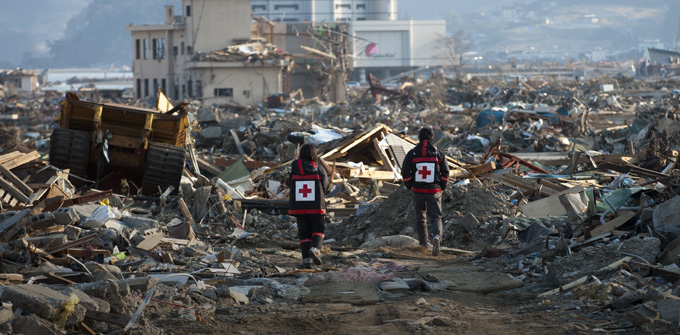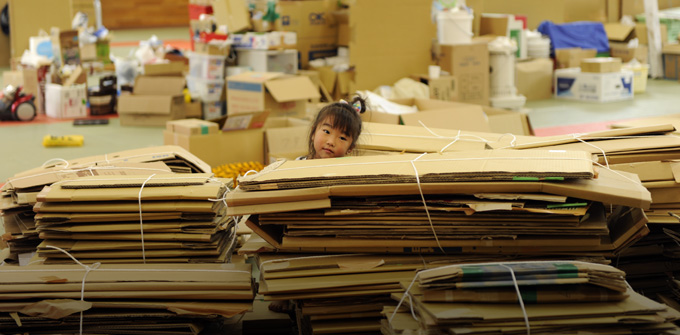Japanese Red Cross played a pivotal role during the triple disaster in March. Tokyo Weekender sat with Satoshi Sugai, Director of The Great East Japan Earthquake Recovery Task Force to hear his view on the year that was 2011.
Tell us about your activities following 3/11?
Our main activities are with our medical teams; we have a network of 92 Red Cross hospitals across Japan. From the first day we dispatched medical teams from these facilities to affected areas, so far we have sent 845 teams. They put up temporary clinics in evacuation centers or in parks if buildings had been destroyed.
How long do your volunteers work in the field?
Some work for just 2-3 days, some for months but that includes loading trucks and collecting funds, as well as help inside the disaster zone.
What are your main challenges in Japan today?
Well, Japan is a “hyper aging” society, by next year, 23 percent of people will be over 65 years of age and in the earthquake-affected areas, 65 percent of people are over 60 years of age which poses a huge challenge. We also have geographic challenges in Japan: on average 26 typhoons hit each year, including three large ones. These can cause floods and landslides, like Typhoon Roke did (in September 2011). Obviously we also have many earthquakes in Japan as well as 108 volcanoes.
How do you coordinate your work with the government?
JRCS is a part of government’s national disaster management structure, and Mr. Konoe (JRCS president) is part of top-level committee who meets with the government. We are called upon if any large-scale disaster takes place. Besides JRCS there are many agencies and ministries and the main relief comes from the Japan Self Defense Forces. They have huge logistics capabilities, and are essential to clear debris and rubble.
What did you do with all the money you collected?
We collect two types of money, individual donations including embassy and corporate donations, which are given to survivors in cash. The JRCS doesn’t take any money for administration, 100 percent goes to the survivors.
With the money collected before the disaster (by regular donations) we paid for many, relief items including delivery of over 132,000 blankets and 13,000 sleeping mats during the emergency phase.
Now, with the donations received from Red Cross and Red Crescent Societies around the world we are supporting people living in prefabricated homes and one of the first things we did was to give survivors home appliances like fridges, TVs, microwaves and rice cookers.
How much did you collect after March 11?
So far we have received 300 billion yen to be distributed to survivors. From the 92 national societies worldwide we have received 53 billion yen (and counting).
The money was enough to run the program in an accountable way for three years, of course more donations means more money for survivors.
Are you still raising money?
Yes, it is still coming in without us even asking and we welcome even one yen more. There are over 70,000 unemployed people and 70 percent of people living in prefabricated houses have no jobs, so the money keeps them going.
How are people in Tohoku coping?
Tohoku was made up of very tight communities and many people struggle being surrounded by strangers. Also we learned from the Great Hanshin earthquake, that in the worst case people could commit suicide.
We try and bring people out to get to know each other, we organize simple things like tea ceremonies, massages or just a chat with people. We also bring doctors and nurses if there are any health issues.
How are conditions now?
I recently went to Otsuchi, in Iwate, where one third of all government workers and the Mayor were killed. The current Mayor said everyone is now out of evacuation centers and living in prefabricated homes, which is good news.
On the national level, the reconstruction planning has begun, the local government is now asking people how to rebuild the affected towns because they are the people who will live there.
Even though there is movement, people are still feeling down. It is understandably quite difficult to be motivated to reconstruct a town that has lost so many people.
Did you have a plan for a disaster this size?
We had a contingency plan for the predicted Tokai earthquake (central-west Japan), not for the Tohoku region. We developed a plan in 2009, some of it worked and some was irrelevant, this disaster was just too big to predict.
How long will you continue your work in Sendai?
Most of our reconstruction projects will continue for three years. The main part will finish in March 2012, the next two years we will concentrate on physical rehabilitation, like hospital building. We plan to finish this phase by 2014.
Will the nuclear disaster make you change the way you do things?
We want to call all Red Cross societies to do something more in case of nuclear accidents, as part of this we are coordinating with the government and TEPCO to decide what to do in the future.
Fukushima is still very concerning, we think we will have to monitor people’s health for 10-20 years. We have not made a conclusion yet.
What is your main purpose in Japan?
Our mandate is to collect money inside Japan, to dispatch and train necessary medical staff when needed and to dispatch relief items such as blankets, sleeping bags and blood.
In other countries, for example the Philippines, Haiti and the U.S. the Red Cross run evacuation centers: in Japan we do not.
The government response system here is very different from other countries, if anything happens the Red Cross [abroad] try to accommodate people in pre-stocked tents.
We don’t do this in Japan because the national law states that local buildings (school gyms, public halls) must be strong enough to serve as earthquake shelters.
How many volunteers do you have in Japan?
Japanese Red Cross has a vast network throughout Japan; we operate one headquarters in Tokyo and one chapter in each of the 47 prefectures.
We have around two thousand groups, with over two million members, including ‘active’ and ‘sleeping’ members.
Most people don’t realize we also have specialized volunteers, such as radio operators and pilots directly registered to our facilities.
Are you still recruiting volunteers?
Not specifically for Tohoku but we always welcome people to join.
We particularly want more young people to join, we have a lot of housewives as members, they are great at cooking the huge pots of food but we brought in AKB48 for a special campaign to help us recruit more young people.
What would you like to see change in the future?
I would like to see better coordination inside the Red Cross and in general across all agencies and NGOs.
Satoshi Sugai, Director of The Great East Japan Earthquake Recovery Task Force has worked for the Red Cross for 27 years. He served in the international department in Geneva and also worked in Afghanistan, North Korea, Kosovo, Rwanda, Pakistan and many other countries.
The Japanese Red Cross Society are still collecting funds, to donate, please visit the website: www.jrc.or.jp/english










